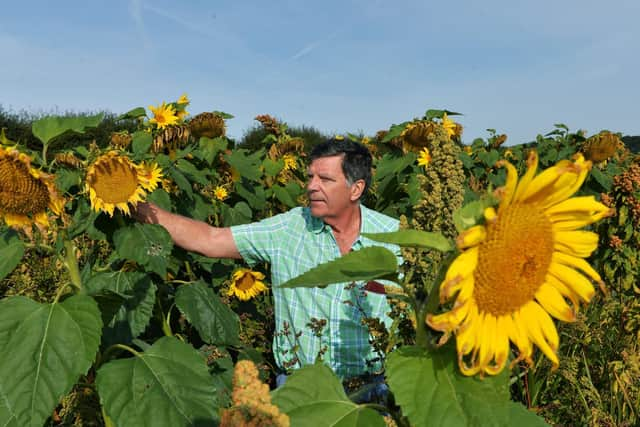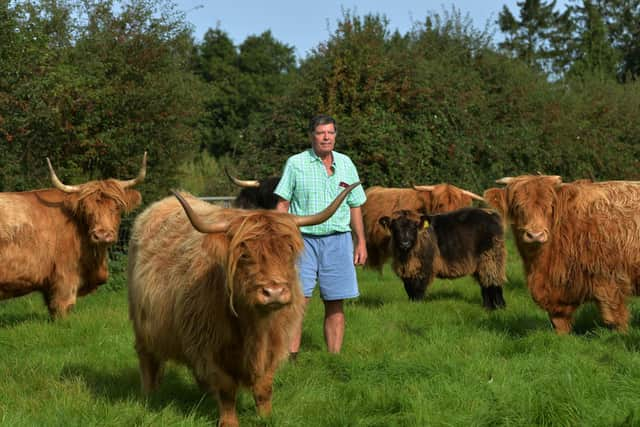Farm of the Week: Conserving centuries-old hedgerows and the world's most northerly chalk stream in East Yorkshire


Arable farmer John Fenton has long been a protagonist of working hand-in-hand with nature, improving the environment, growing crops that meet the right markets and breathing fresh life into children’s understanding.
John was recipient of the Tye Trophy for the East Riding from the Yorkshire Agricultural Society just over a decade ago, for his work in conservation and went on to take second place in the coveted FWAG Silver Lapwing national award the year later.
Advertisement
Hide AdAdvertisement
Hide AdJohn has been the lead judge for the Yorkshire Agricultural Society’s annual awards for the past five years and said he is enthused by what he sees around the north of England.


“There is a phenomenal amount of work going on, largely unsung and it is such a privilege to visit those who are working so hard. I wish more was known and understood about it because it is a fantastic story to tell, particularly among those who are joining together collectively.
“Here at Elmswell we have 28 miles of hedgerows and 48 miles of field margins. We have planted 15 miles of hedgerows through being involved with stewardship schemes, but our main hedgerows date right back to the 1700s. Last year we didn’t cut any of them because it was too wet and now they are just brimming with fruit and doing phenomenally well. The copious amounts of butterflies, bees and insects is an absolute delight. We have 40 beehives. Pollinators are very important.”
One of John’s major conservation projects has involved Elmswell’s 100 acres of commercial woodland where he has been busily taking out a good deal of his poplar trees to assist the river system from Elmswell Beck. John said that along with putting in silt traps the moves have improved the water flow and its quality.
Advertisement
Hide AdAdvertisement
Hide Ad“Our driver is to improve the quality of water as much as possible. We put the silt traps in about ten years ago to stop silt from going into the beck and during the past decade we have taken out 5000 tonnes of poplar.


“Our stream is one of only 210 chalk streams in the world and the most northerly and the habitat and wildlife associated with them is therefore particularly rare.
“The poplars were originally planted in the 1960s for use as pit props in mines and for matches. Both of those industries having now largely gone there is little demand for a commercial poplar crop and the poplar are one of the worst for translocation of water.
“Taking them out has had a very dramatic effect on creating more of the spongy areas around the river which is what we wanted and it has had a really good year of the water now being able to get away.”
Advertisement
Hide AdAdvertisement
Hide AdJohn has also been taking out ash, largely down to ash dieback, but he said it has found a useful market.
“Timber production is all part and parcel of what we do. The ash that has come out went towards logs for wood burning stoves.
“Our predominant trees are alder and willow, but we also have a lot of sycamore, ash and good numbers of oak and beech. We have been growing cricket bat willow for a number of years and we have just started harvesting those.”
John said his hedgerows, field margins, woodland and river management contribute to a vibrant bird and wildlife populus.
Advertisement
Hide AdAdvertisement
Hide Ad“We go from kingfishers right through to buzzards with lots of chaffinch, sandpiper, larks, small farmland birds and migratory birds and geese in winter. The river has grassland SSSI land, we have several bird mixes for feed and there are large open expanses of water. We also have our fair share of roe deer, foxes and badgers and in the river are brown trout."
Grazing the SSSI land are John’s only livestock at Elmswell, his Springwell Fold of Highland cattle that he has expanded from an initial four heifers to 28 breeding cows with followers. He lost his maiden sire, which had been breed champion at the Great Yorkshire Show and reserve champion at the Royal Highland Show and originally came from Mull, earlier this year.
Elmswell runs to just over 1,400 acres with 1000 of them down to arable cropping. John grows around 630 acres of seed wheat that yields between 4 to 4.5 tonnes per acre. This year one of his varieties Extase came in at 4.3 tonnes. All of his seed wheat goes to Frontier in Cranswick. Vining peas going to Bird’s Eye make up 185 acres and this year for the first time he has grown 100 acres of ryegrass.
“We’ve now gone for ryegrass, which is a good break crop and we have a market for it into horse feed and what I call ‘bunny munch’ pelletised for rabbits and hamsters. The vining peas have always been a good crop and we are part of The Green Pea Company farmers collective.”
Advertisement
Hide AdAdvertisement
Hide AdJohn converted a redundant livestock building into a purpose-built classroom ten years ago and said his vision was to educate future generations about farming.
“I believe it is fundamental that people understand where food comes from, how it is produced from crops and livestock, and wildlife and conservation.
“In 2019 we had 58 school days with some visiting four times during the year to experience each season. One of the schools told me that they keep daily records of their children and are able to see that, since they have been coming here, some of the countryside and wildlife vocabulary that had disappeared was now coming back.”
He added: “We have an extraordinary farm with every field being south facing, and we have 17 different soil types which makes life challenging. Fortunately I have two highly competent and committed men working with me - Shane Cooper and his protégé Harry Walker.”